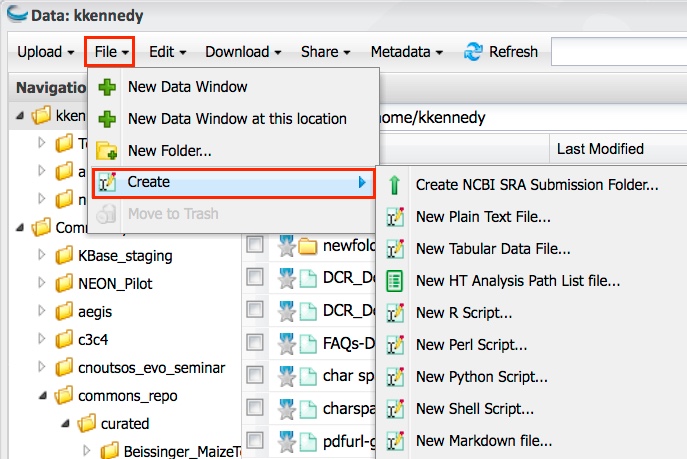Creating New Files and Folders¶
You can create new small files and folders in your personal Data folder. File types include plain text, tabular data, R script, Perl, Python, Shell, and Markdown files. You also can create a list of files to use in HT (high-throughput) file execution.
After you create it, you can edit and move the file or folder.
Before you begin, you may want to watch a YouTube video on file creation, file editing, and tabular views.
| See Using Special Characters in the DE for notes about file names. |
Creating new folders¶
- In the Data window, select the personal folder under which you want to add the new folder.
- Click File and then click New Folder.
- Enter a unique name for the new folder and click OK.
Creating new files¶
You can create new plain text and tabular data files, as well as files using R script, Perl, Python, Shell, and Markdown. You also can create a high-throughput file list.

NCBI SRA Submission Folder¶
You can create an NCBI SRA submission folder and then define its name and number of biosamples and libraries.
- In the Data window, select the personal folder under which you want to create the new submission folder. You can move it later if necessary.
- Click File, click Create, and then click Create NCBI SRA Submission Folder.
- In the setup window, enter the project name, number of biosamples, and number of libraries.
- Click OK.
Plain text file¶
- In the Data window, select the personal folder under which you want to create the new text file. You can move it later if necessary.
- Click File, point to Create, and then click New Plain Text File.
- In the file window, enter the text.
- When done, click Save, select a location in your personal folder space, enter a unique file name, and click OK.
Tabular data file¶
HT analysis path list file for use in high-throughput and batch file execution¶
You can create a high-throughput analysis path list file for use in high-throughput and batch file execution. This allows you to feed a single file that is basically a list of up to 16 files into an app that supports a single file or single folder as input. The same analysis is then run concurrently on the first 8 files in the list, with any subsequent files queued for later submission. All files in the list must use the same parameters, and it is available for all apps in the DE, including Agave apps.
Once you have created and saved your list file by dragging the files from the Data list to the HT window, you can submit it as the input file in an analysis using any app. You can check the status of each file in the list as it is executed.
Note: Each path from each HT list will be paired for each job, so each HT list used in an app must have the same number of paths. For example, if each HT list has 10 paths, 10 jobs will be run.
In the Data window, click File, point to Create, and then click New HT Analysis Path List file.
In the Data window, navigate to the first file to add to the list, and then drag it to the HT window.
Repeat for each file to add to the list. Remember that all files must have the same parameters when you create the analysis.
When the high-throughput list is complete, select the folder to which you want to save the file, click Save, and enter the filename (no spaces or special characters in the filename or folder).
You can move it later if necessary. The file is displayed in the selected folder with an icon
to the left of the name to indicate it is a high-throughput list file (you may need to refresh the window) and may now be used in an analysis, just like any other file.
Submit the list file as the single input file in an analysis in any app.
To view the status of each file’s progress in the analysis, click
next to the analysis name in the Analyses window.
R script, Perl script, Python script, or Shell script file¶
- In the Data window, select the personal folder under which you want to create the new script file. You can move it later if necessary.
- Click File, point to Create, and then click either New R Script, New Perl Script, New Python Script, or New Shell Script.
- Enter the text using the commands for the script.
- Click Save.
Markdown File¶
- In the Data window, select the personal folder under which you want to create the new Markdown file. You can move it later if necessary.
- Click File, point to Create, and then click New Markdown file.
- Enter the text and click Save.
Fix or improve this documentation:
- On Github: Github Repo Link
- Send feedback: Tutorials@CyVerse.org
- Live chat/help: Click on the
 on the bottom-right of the page for questions on documentation
on the bottom-right of the page for questions on documentation
